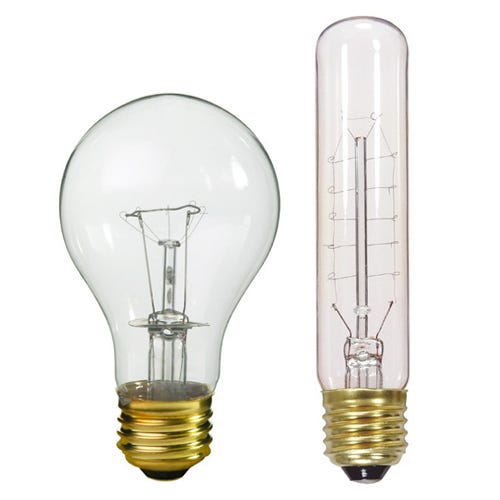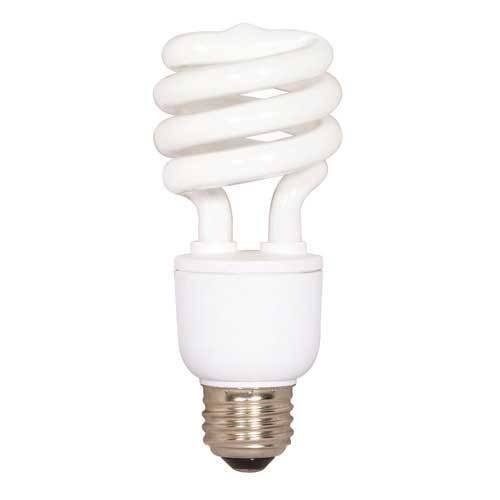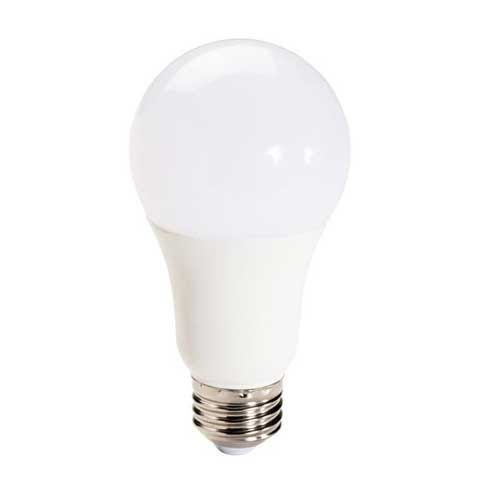Understanding different light bulb types and applications should be easy right? However, with over 100 different types, styles and applications of bulbs, it becomes very easy to buy the wrong bulb for the job.
Luckily, identifying the right light bulb for you can be easy when you know what to look for!
So lets take a look at the 6 types that all light bulbs fall into and I promise that by the end of this article you will be fully equipped with the information to choose the right bulbs for your home, office or wherever it is you need a light bulb.
The Evolution of Lighting & Incandescent Bulbs
Up until about a little over 200 years ago the only indoor light we used to illuminate our homes was that of candles, chandeliers and fire places. While wonderfully warm and cozy, open flames aren’t always the safest nor the most efficient.
Although light bulbs had been invented nearly 100 years before Edison’s practical incandescent bulb in 1878, only the turn of the century showed home light bulbs to become commercially available.
With the use of carbonized tungsten filaments, Edison’s light bulbs out performed all others and the incandescent bulb became the standard by which we all think of electric lighting.
Incandescent bulbs last an average of 1 year and can be very inexpensive to replace. However, incandescent bulbs have poor energy efficiency and can run very hot to the touch.
Incandescent bulbs are dimmable, meaning they can work along side a dimmer switch or ballast so that the light produced can be manipulated to be darker or lighter.
Incandescent Bulb Pros and Cons

- Incandescent bulbs have a lifespan of about a year
- Incandescent bulbs are very affordable
- Incandescent bulbs can be used with a dimmer
- Incandescent bulbs are not energy efficient
- Incandescent bulbs have limited color temperature
- Incandescent bulbs have a tendency to run hot
Compact Fluorescent Lamps & The Start of Energy Efficiency
The incandescent reigned supreme for quite some time until the CFL or “Compact Fluorescent Lamp” was introduced. The parent to the modern fluorescent lamp was invented in the late 1890s by Peter Cooper Hewitt. The Cooper Hewitt lamps were used for photographic studios and industries.
Although the first CFL bulbs were invented by GE in the 1970’s, it wasn’t until 1995 when the helical CFL was manufactured in China and made commercially available. It is the spiral tube that helps us identify CFLs today.
CFLs consist of 2 different types which are called Integrated and Non-integrated lamps. Integrated lamps combine the tube and ballast in a single unit, which makes it easy for users to replace incandescents with CFLs.
Integrated type CFLs work well in many standard incandescent light fixtures, reducing the cost of converting to fluorescent. However, be sure to check the packaging when buying CFLs to replace incandescent bulbs in a dimmer switch. There are specific types of Compact Fluorescents that are created for that purpose.
CFL’s are much more energy efficient and can last anywhere from 8 and 15 times longer than your typical incandescent.
Non-integrated CFLs have the ballast installed in the bulb base and usually only the fluorescent tube is changed at its end of life. Since the ballasts are placed in the light fixture, they are larger and last longer compared to integrated ones, and they don’t need to be replaced when the tube reaches its end-of-life.
The CFL type bulb came into commercial use in response to the alternative energy concerns of the 1970s. These CFL bulbs use a folded fluorescent tube along side tri-color phosphorus and a solidified form of mercury called mercury amalgam. The amalgam is most commonly a combination of mercury and tungsten when used in light bulbs.
Because of the CFL’s use of potentially harmful chemicals, disposal of CFLs can be a challenge and now most people are trading in CFLs for much more safe and even more efficient LED bulbs.
Compact Fluorescent Lamp Pros and Cons

- CFLs have a longer life than incandescents
- CFLs are energy efficient and save money
- CFLs can be fairly inexpensive in comparison to LEDs
- CFLs contain mercury and other chemicals
- CFLs have special instructions for disposing them
- CFLs have multiple base types which can be confusing
LED Light Bulbs & The Future of Lighting
LED technology has grown exponentially in recent years and now LED type bulbs are making big changes in the lighting industry. The LED lamp market is projected to grow by more than twelve-fold over the next decade, from $2 billion in the beginning of 2014 to $25 billion in 2023, a compound annual growth rate (CAGR) of 25%. As of 2016, LEDs use only about 10% of the energy an incandescent lamp requires.
The First LEDs were developed in the 1960’s. These early LEDs were not only low powered but also only capable of emitting light in the low, red frequencies of the light spectrum. In the early 1990’s, the first high-brightness blue LEDs were introduced by the Nichia Corporation, a private electronics business in Japan.
After the creation of the blue and high-efficiency LED, work began then to create the first white colored LED which uses a phosphorus coating to partially convert the blue emitting LEDs to red and green colors which ultimately appears white to the human eye.
LED lamps are made of arrays of SMD modules which are specific types of LEDs that can be directly attached to a printed circuit board. Most LED bulbs come equipped with the household standard Edison screw base and can be installed into almost any standard fixture. Some modern LED bulbs can be installed with a dimmer, however, most LEDs have a directional light characteristics.
LED light bulbs have been shown to be much more energy efficient than both incandescent and fluorescent bulbs combined. Some more modern LED bulbs can have a lifespan of up to 20 years. Imagine not needing to replace those household light bulbs for 20 years.
LED bulbs are also much safer than incandescents and fluorescents as they do not contain any hazardous chemicals. Since LED bulbs emit 5 time less heat than incandescent bulbs, they are safe to touch and have proven to have great purpose in the hydroponics industry.
Disposal and clean-up of broken LED bulbs couldn’t be more simpler. No longer need to worry about glass shattering as most household LED bulbs are made entirely of plastics.
LED Light Bulbs Pros and Cons

- LEDs have a lifespan of up to 20 years
- LEDs are immensely safe and don’t contain any hazardous chemicals
- LEDs can be installed directly into most fixtures
- LEDs can be much more expensive than other bulb types
- LEDs can emit more unnatural looking light
- LEDs have multiple base types which can be confusing
